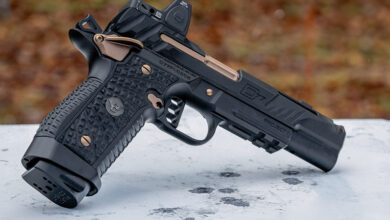Earplugs and Earmuffs: Hearing Protection Options for Shooting Sports

Eye protection is an important part of any shooting sport, particularly if you are shooting at a target that has the potential to be reactive. If you don’t use eye protection and get blowback, you know it immediately, and it is too late. Hearing protection, such as earplugs and earmuffs, are just as vital despite that the ill effects of not using them are usually felt years after the fact. That begs the question: which do you pick? Let’s take a look at the pros and cons of earplugs and earmuffs and why you might choose one over the other.
Earplugs: Low Tech, Discreet, and High Impact
I started out wearing earplugs, and I wear earplugs with every shot I take. That concept was literally drilled into my head by my grandfather. He was a Korean War veteran and a lifelong hunter who never wore ear protection. By the time he hit his 60s, he was completely deaf in out of one ear. He made sure I was wearing them, whether I was sighting in a rifle with him or in the field. Curiously, he never adopted the practice. Old habits die hard, I suppose.
Earplugs have a lot going for them. They are simple foam plugs that you simply shove into your ear canal to dampen and mitigate harmful noises. This simple technology is available in large quantities in bags or jars, and some public ranges will have packets containing pairs of earplugs.

Earplugs are cheap, available, and effective. But I prefer them for their discreetness. It costs you nothing to toss a pack of plugs into your pocket before you head out the door for your outdoor adventures. There have been occasions where I have forgotten earmuffs or simply lacked the room to take them along, particularly on hunting trips where space is limited.
Although earplugs are usually plain foam inserts, there is no shortage of models with bands to prevent you from losing the plugs. Furthermore, electronic earplugs like the Caldwell E-Max have made real inroads in recent years. These operate much like music earbuds, except they allow you to tune out high-decibel noise while enhancing low-decibel noise, so you can safely shoot but still hear someone talk next to you.
However, earplugs are not always the best choice. Earplugs require some technique to wear properly. You have to squeeze them in your fingers before inserting them into your ears to ensure a snug fit. Simply shoving them into your ears can work, but sometimes, they fit too loosely to keep noise out. In addition, when you are shooting particularly powerful rounds, you can still get some concussion and sound coming through. I found this to be the case when shooting belted magnum rifle cartridges and magnum revolver rounds. In those cases, I like to wear earplugs and earmuffs!

Earmuffs: For the Best Possible Protection
If you want the best possible protection against even the highest-powered rounds, shot after shot, earmuffs have no peer. With earmuffs, you get the benefit of having more material between your ear and the source of the noise. In fact, most earmuffs are designed to fit snuggly over the entire ear. The hollows around the ear canal can still transmit uncomfortable vibrations coming from loud noise. Earmuffs effectively give you more coverage as well as more material around the ear compared to plugs.
Earmuffs vary in terms of size and features. A pair of basic earmuffs like the Walker Razor Passive earmuffs will cover just about any shooting need. But electronically powered earmuffs like the Walker Razor Slim or the Pelcor ComTac have been available for years. These allow you to hear and use your indoor voice while tuning out gunfire.
In terms of overall protection, earmuffs provide the best possible protection for your hearing. Although more expensive than earplugs, earmuffs are larger and harder to misplace. However, earmuffs may not suit every situation. They take up more space in your pack, and getting a pair that fits comfortably can be a challenge. The band and pads can be too small for some shooters. Earmuffs with larger pads can also be bumped off the shooter’s ear, particularly when shooting rifles with a healthy dose of recoil.
Earplugs and Earmuffs: Both Better than the Naked Ear
Earplugs and earmuffs have their advantages and disadvantages. Foam earplugs sacrifice some protection for discretion, while earmuffs maximize protection at the expense of size. How that will affect you depends entirely on what you shoot and how you shoot. But no matter what you prefer, be sure to have them on or in your ears when you pull the trigger if at all possible. In some cases, you will know you have damaged your ears. Tales of ruptured eardrums when firing magnum rounds indoors abound. But it is the damage you don’t immediately register that is often the most lasting. Permanent hearing damage comes from cumulative events, and you don’t need to be around heavy-hitting rounds to do damage. Even the low report of the kid-friendly .22 LR can be onerous after a long-range session. Enough of those, and lasting damage ensues. Save your ears and put a plug in it.
The post Earplugs and Earmuffs: Hearing Protection Options for Shooting Sports appeared first on The Mag Life.
Read the full article here




![[FIRST LOOK] Strike Industries EMP With LED [FIRST LOOK] Strike Industries EMP With LED](https://firearm-discounts.com/wp-content/uploads/2024/12/SI-EMP-3-390x220.jpeg)

